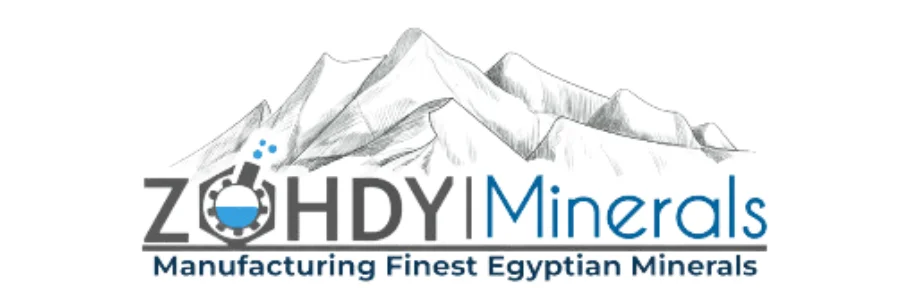Calcium carbonate found in limestone is a chemical compound with the molecular formula CaCO₃ and a molecular weight of 100.09 g/mol, consisting of one calcium atom, one carbon atom, and three oxygen atoms. It naturally exists in many types of rocks and is considered the main component of limestone.
Physical Properties of Calcium Carbonate
It consists of white or gray crystalline rocks, which, when ground, turn into a fine, white, odorless, and tasteless powder that is insoluble in water. Calcium carbonate (limestone) naturally occurs in different forms such as chalk, limestone, marble, and sedimentary rocks, formed over millions of years from the deposition of shells, mollusks, and corals.
Although the chemical composition remains the same, calcium carbonate varies in whiteness, purity, thickness, and homogeneity.
It is composed of three main elements: carbon, oxygen, and calcium, found abundantly in rocks worldwide. Limestone is the most common example and is also the main component of seashells, pearls, snail shells, eggshells, and coal nodules.
Calcium carbonate is an essential mineral widely used in many vital industries, including paints, coatings, sanitary ware, adhesives, plastics, pipes, electrical equipment, automotive parts, toys, stationery, rubber, paper, glass, pharmaceuticals, cosmetics, toothpaste, animal feed, fertilizers, pesticides, water treatment, cement, and building materials.
Sizes and Forms of Calcium Carbonate:
-
Coarse Granules:
Range between 2 mm to 9 mm or 1 cm to 40 cm, packed in 50 kg bags or jumbo bags (1 ton).
-
Fine Powder (Ultra-Fine):
Ground particles range from 10 microns to 500 microns.
What is the Difference Between Ground Calcium Carbonate (GCC) and Precipitated Calcium Carbonate (PCC) ?
Both have the same chemical formula (CaCO₃) but differ in production methods, physical properties, and final applications.
Production:
-
Ground Calcium Carbonate (GCC):
Produced by mechanical grinding of raw limestone and then classified by particle size. No chemical change occurs during this process.
-
Precipitated Calcium Carbonate (PCC):
Produced through a series of chemical steps:
-
Calcination:
Heating limestone15rt` in a kiln at ~1000°C to produce quicklime (CaO) and release CO₂.
-
Slaking/Hydration:
Mixing quicklime with water to produce calcium hydroxide (Ca(OH)₂), also known as milk of lime.
-
Carbonation:
Bubbling CO₂ through the milk of lime to precipitate calcium carbonate again.
-
Filtration & Drying:
The resulting calcium carbonate slurry is filtered and dried into powder.
This process allows control over particle size, shape, and purity, making PCC more refined and suitable for advanced applications compared to GCC.
Differences Between PCC and GCC in Properties
- Chemical Composition:
Both are similar, but GCC may contain more impurities such as silica and trace metals, while PCC is purer. - Particle Size & Shape:
- PCC: Exhibits uniform, controlled, and often nano- or micro-sized crystals.
- GCC: Irregular particles with less control over size and shape.
- Particle Size Distribution:
- PCC: Narrow and controlled size distribution, enhancing oil absorption and surface properties.
- GCC: Broader size distribution, with both very large and very fine particles.
Advantages of PCC over GCC:
- Better impact resistance in plastics.
- Higher oil absorption in coatings and adhesives.
- Greater control of whiteness and brightness.
Natural Calcium Carbonate (GCC)
Natural calcium carbonate is obtained directly from limestone, marble, and chalk. It is widely known as Ground Calcium Carbonate (GCC).
-
Production:
Extracted from rocks and mechanically ground.
- Chemical Formula: CaCO₃
-
Key Properties:
- High purity suitable for sensitive industries.
- Chemically stable and resistant to reactions.
- Good dispersibility, allowing easy blending.
- Strong whitening ability for paper and paints.
Applications of Calcium Carbonate in Industries
-
Paints & Coatings:
Improves coverage and gloss.
-
Plastics:
Acts as a filler to enhance rigidity and reduce costs.
-
Food Industry:
Used as a food additive and calcium supplement.
-
Pharmaceuticals:
Source of calcium and excipient in tablets/capsules.
-
Cosmetics:
Used as a filler and whitening agent.
-
Paper:
Enhances brightness, whiteness, and strength.
-
Rubber & Tires:
Improves durability, elasticity, and processing.
-
Chemicals & Agriculture:
In fertilizers, pesticides, and water treatment.
-
Construction Materials:
Used in cement, tiles, ceramics, and adhesives.
What is Precipitated Calcium Carbonate (PCC) ?
PCC is a high-purity form of calcium carbonate produced by chemical synthesis, also known as synthetic calcium carbonate.
-
Production
Produced by dissolving quicklime (CaO) in water, then bubbling CO₂ to form controlled crystalline calcium carbonate.
-
Chemical Formula
CaCO₃ (same as GCC, but with different morphology).
-
Key Properties
- Ultra-fine particle size with uniform crystal structure.
- Higher purity compared to GCC.
- Controlled physical and chemical properties.
-
Applications
-
Paper Industry
Improves whiteness, brightness, and smoothness.
-
Plastics
Enhances toughness and rigidity.
-
Paints & Coatings
Improves opacity, gloss, and resistance.
-
Rubber:
Enhances elasticity and durability.
-
Food & Pharmaceuticals:
As a calcium source and excipient.
-
Cosmetics:
Provides brightness and smoothness.
-
Construction Materials:
Used in cement and adhesives.
-
At Zohdy Minerals Egypt, we provide both Precipitated Calcium Carbonate (PCC) and Natural Calcium Carbonate (GCC), ensuring high-quality products tailored to meet industrial demands.






